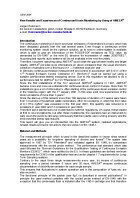Air Monitoring
New Results and Experiences of Continuous Dioxin Monitoring by Using of AMESA
Oct 06 2014
Author: Jürgen Reinmann on behalf of CEM
Introduction
The continuous monitoring of dioxin and furan emissions of incinerators is a topic which has been discussed globally over the last several years. Even though a continuous on-line monitoring system would be the optimum solution, up to now no online-system is available which is able to give an information of the PCDD/PCDF emissions as TEQ value, as demanded by EN-19481 or the new EU directive for incineration of waste 2000/76/EC2. According last reports, such systems will be not available in the next few years.
Therefore, long-term sampling using AMESA could close the gap between reality and target results. AMESA provides more informations on dioxin emissions than the usual short-term collection of samples over a few hours on 1 – 3 selected days per year. In Germany continuous emission measurement and control in accordance with §10 (1) of the 17th Federal Emission Control Ordinance (17. BImSchV)3 must be carried out using a suitable (performance-tested) measuring device. Due to this regulation we decided to do a performance test for AMESA by TÜV Rheinland in 1997.
Since the first installations of the TUV approved AMESA systems in 1997, AMESA became more and more as a standard for continuous dioxin control in Europe. More than 70 installations give a lot of information’s. After starting of the continuous dioxin emission control in the Wallonia region with the 1st January 2001, in this area exist now experiences of the dioxin emissions of more than 3 years4.
Since the start-up of this network more than 700 samples of duration of 2 weeks ware taken from 12 burners of household waste incinerators. After 20 occasions, in which the limit value of 0,1 TEQ ng/Nm3 was exceeded in the first year 2001, this quantity was reduced to 9 occasions in year 2002 and 12 occasions in year 2003. Therefore some plants had to be modernised to fulfil the regulations. Of course, these leaded at first to new investments, but after these investments, the operators had an instrument to calm down the public by showing continuously that their plants were running properly and the environmental stress was reduced.
This report will give you an introduction into the AMESA system, realised applications, newest results and some remarks to the new version of EN-1948-1.
Digital Edition
AET 28.2 April/May 2024
May 2024
Business News - Teledyne Marine expands with the acquisition of Valeport - Signal partners with gas analysis experts in Korea Air Monitoring - Continuous Fine Particulate Emission Monitor...
View all digital editions
Events
Jul 30 2024 Jakarta, Indonesia
China Energy Summit & Exhibition
Jul 31 2024 Beijing, China
2024 Beijing International Coal & Mining Exhibition
Aug 07 2024 Beijing, China
IWA World Water Congress & Exhibition
Aug 11 2024 Toronto, Canada
Aug 25 2024 Stockholm, Sweden and online






.jpg)








